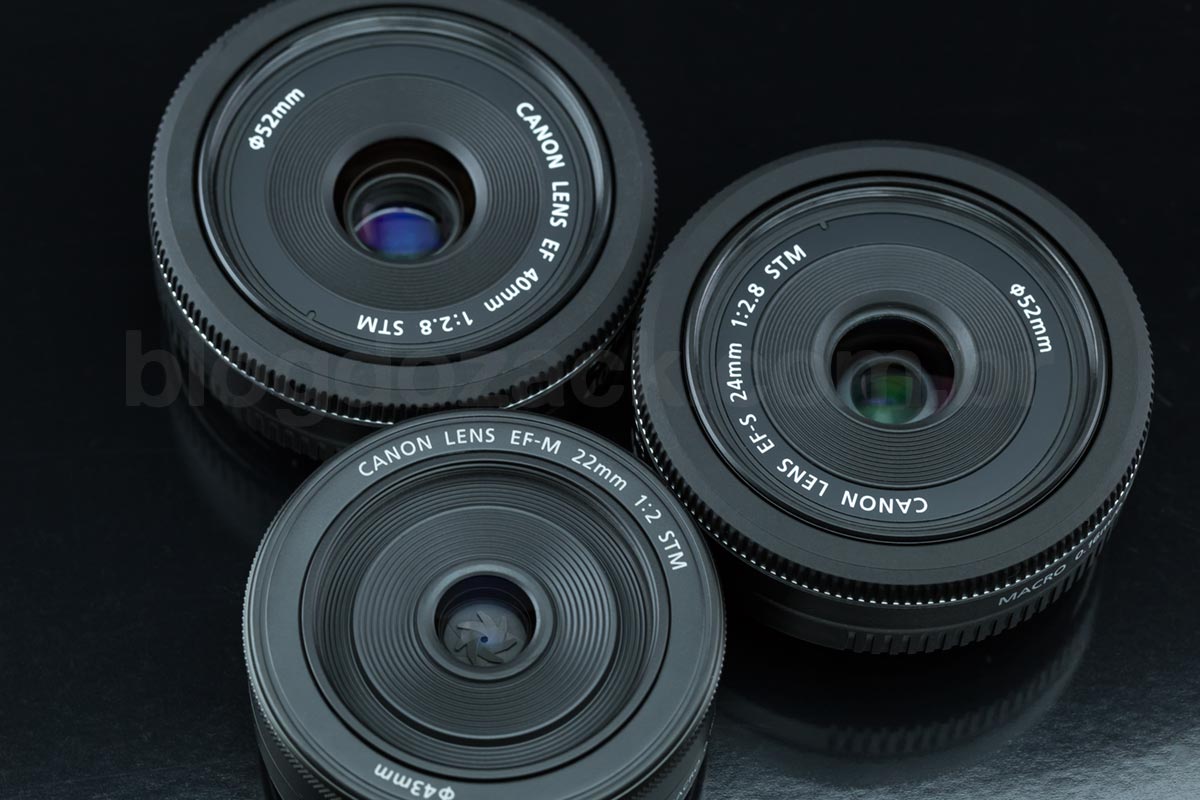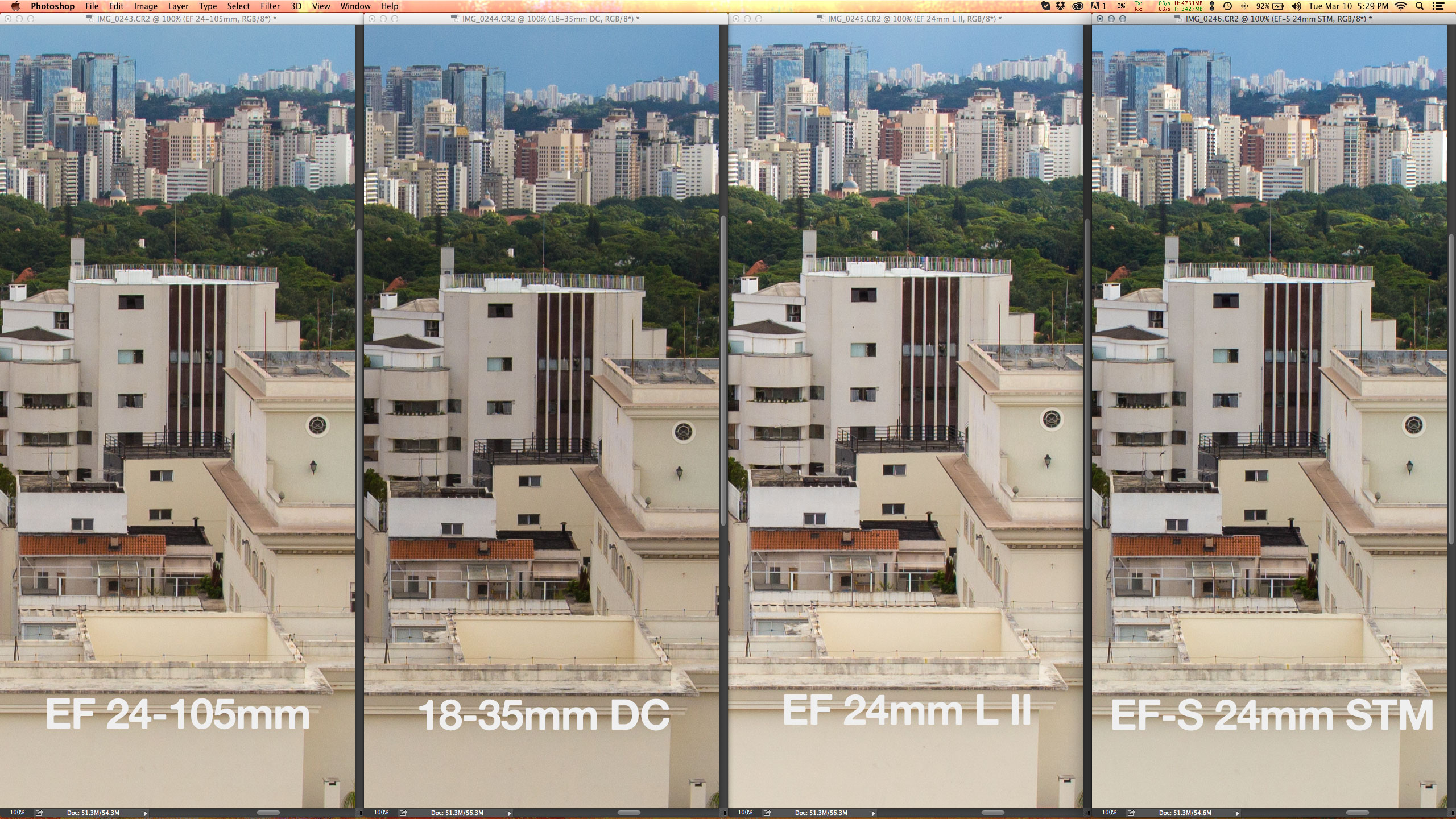Estimated reading time: 09 minutes.
March/2015 - The Canon EF-S 24mm f/2.8 STM is the third Canon pancake lens, identical to the EF 40mm f/2.8 STM and similar to the EF-M 22mm f/2 STM. When rumours started about a new compact prime lens, the possibility for it to be a wide angle 24mm excited the market, hoping for a new “mini” entry level EF line with diverse focal lengths: 24mm, 40mm, maybe a 65mm in the future… But after the first images leaked and we saw the EF-S moniker, it hit us: Canon would introduce a pancake lens for each format: EF 40mm, EF-M 22mm, and now the EF-S 24mm.

But make no mistake. It’s not because it’s an “EF-S” that it’s not a 24mm after all; it is! On the APS-C format it is not really wide angle, but more like an ideal standard for street photography. It is much wider than the EF 40mm: 59º against 31º. It just won’t cover the 135 full frame circle and that’s why its price dropped US$149, besides the same features: short build, STM AF and modern optical formula. Canon actually wants to kill the EF 50mm f/1.8 II for street shooters.
It got on vlog do zack by popular demand once I already have many other combos that do the same thing. The EOS M + EF-M f/2 STM is even smaller (no adapter required) and brighter. And the full frame Sony RX1R with its 35mm f/2 prime lens is an optical monster, much superior but also much more expensive. But the EF-S 24mm f/2.8 STM will mount on any APS-C EOS camera, and the US$149 price tag is unbeatable considering its results. I’ll say first hand it is one of the coolest primes on Canon’s lineup, so don’t think twice before buying it. We have a winner. Nice reading!

At 125g of six elements in five groups, with a 22.8mm length and 68.2mm width, the EF-S 24mm f/2.8 is the EF 40mm f/2.8 STM twin with the same six elements (in four groups) and 130g. If you own the 40mm pancake, you’ll feel right at home with the EF-S 24mm. Together they’re both thinner than the EF 50mm f/1.8 II alone, and they feel like a camera cap instead of an optical instrument, besides the built-in stepping motor, ø52mm filter thread, manual focusing ring and metal mount. The biggest difference is the EF-S rubber bump that prevents it from being mounted on a EF only camera, not compatible with full frame EOS cameras like the 5D or 6D series.

Because it’s so short, the build feels very robust and much more solid than larger low cost lenses like the plastic fantastic 50mm. You can mount your pancake lens and forget about it, as it will probably sit safely behind the flash unit built on every APS-C EOS. It’s a dream to have it with you at all times on a SL1 DSLR or M mirrorless. It is clear that Canon won’t introduce a premium APS-C compact (hello, Fuji X100!), and instead they’re offering the same thing for your actual DSLR.

The EF-S 24mm STM operation is dead simple with a single AF/MF switch and a fly-by-wire manual focusing ring. It is rubberised and much better to the touch than the plastic-on-plastic 50mm f/1.8 II. And it features the full time manual: at any moment, even at AF, you can compensate using the ring. It will send an electronic signal to the stepping motor and move the internal optical piece, that expands almost 1cm at the minimum focusing distance (16cm). And as it’s electronic, it requires power from the camera, so you’re out of luck with passive mounts or adapters.

The STM focus is typical. Silent, smooth, won’t get any speed awards. It works for street photography, graffiti, architecture, people. Just don’t point it at moving kids and expect it to lock instantly. It takes about one full second on the EOS M if it doesn’t get confused by other sharp elements like some bokeh balls, missing the correct spot. And you can see it on the LCD when it’s wrong, because it is very wrong. But nothing to worry about: of 400 photos, it happened once.

Finally another Canon low cost lens with great build quality, perfect usability and different pancake design, raising some questions about the rest of the line. For just US$149, it makes me feel we’re paying too much for the US$125 EF 50mm f/1.8 II and too much for the US$199 EF 40mm f/2.8 STM. Actually, it is waaay too much for the US$599 EF 35mm f/2 IS USM, that’s from the same design school and build quality; I will never get over this f/2 IS price. The EF-S 24mm f/2.8 STM feels very premium considering its results, and it’s not low cost at all. Well done, Canon!
With a tiny optical arrangement at the center of the EF-S mount, and not forgetting we’re talking about a wide angle after all, it’s impressive what Canon delivered on the EF-S 24mm f/2.8 STM. Its resolution is impeccable and aperture-independent. The contrast is perfect from f/4. And its colours, as always, are the best part of the EOS system, after some software grading. We’re not depending on modern coatings or aspherical elements, but raw glass quality. The US$149, I repeat, are very cheap for what it delivers. All photos with the Canon EOS M.
On an everyday basis at f/2.8, the only “problem” is the short depth of field that makes it hard to get perfect focus on tridimensional elements; an often desired street photography look. The resolution is high on whatever falls on the focal plane from edge to edge, and we don’t have to stop it down to get more details on our files. But the contrast and the vignette gets better at f/4, so take it in consideration if it’s important to you. We’re past the time when optical performance was related to the f/stop, and it will just control the depth of field after all.

100% crop, but at ISO100 we can see it’s very sharp indeed.
The important thing is that pictures are full with details from APS-C cameras, rivalling any full frame camera for 90% of the situations. Its files can handle very large prints, bigger than most of you plan on printing, and the remaining 10% are for the different large sensor look and their performance under low light. For everything else, what these compact cameras can do with even the smallest lenses is years ahead of any smartphone, no matter what Apple says.

100% crop, impeccable center details…

100% crop, great fine line details on contrast areas.

100% crop, moiré on the EOS M with so much sharpness.
Chromatic aberrations are very discrete and I dare to say it’s the best Canon 24mm lens in this aspect. Those colourful lines around contrast areas on the edges are never bigger than 1 pixel on the APS-C 18MP EOS M, a much (much!) better performance than even the EF 24mm f/1.4L II USM (!), the TS-E 24mm f/3.5L II; or Sigma’s 18-35mm f/1.8 DC HSM that was tested at the same place. There’s no need to turn the DIGIC5 correction nor the software correction in post, very impressive. And on the background, the axial chromatic aberrations are nowhere to be seen neither: smaller optical elements = invisible aberrations. It is different than using larger lenses stopped down. If you know you won’t be shooting wide open, don’t carry a f/1.4 lens with you.

100% crop, the lateral CA is there, but it is very discreet even on extreme situations.

100% crop, there was no software correction here, it’s not necessary.

100% crop, where’s the lateral CA? O_o
The geometric distortion can be an issue on urban straight lines. It’s barrel type near the top and bottom edges, asking for different framings to hide the problem. If you can’t avoid it, any camera or software can fix it in post. Again, it is much less than any 24mm zoom and not really a worry. Flaring, on the other hand, can happen on backlit scenes if the source is near the edges of the frame. But the contrast can be enhanced on software and we don’t see those weird coloured lines.
But the bokeh is not really its strong point; on any 24mm f/2.8 lens. The short focal length and the not-so-small aperture are not ideal for those looking for shallow depth of field. You can try to separate your subject from the background getting very close to it, but it works only on smaller items and it won’t be very smooth anyway. The lines can get a bit repetitive and the highlights get a “condom effect” due to the aspherical shaped element. It wasn’t made for bokehlicious shots.

100% crop, the bokeh is a bit confusing, very repetitive circles.
Last but not least, the colours seal the deal of the EF-S 24mm f/2.8 STM. Personally one of the most interesting aspects of doing the vlog do zack is to test many different brands and lenses, noticing the very different colour rendering of each. And man, Canon is the only one that can render beautiful colours for prints and for screens. From the EOS M back LCD I could tell I was going to have very saturated tones on primary yellow, blue and red colours; captured on their RGGB Bayer arrangement. So it is not the easiest thing to get great colours from CMOS sensors, but they look great on every EOS. It is perfect for graphic designers, street shooters, or just to enhance a fine weather when you’re out on the streets. If you’re into graffiti art, this lens is for you.
Just because I can, I put the EF-S 24mm f/2.8 STM side by side with popular “high-end” lenses that also offer the 24mm distance. From left to right: EF 24-105mm f/4L IS USM, Sigma 18-35mm f/1.8 DC HSM, EF 24mm f/1.4L II USM and the EF-S 24mm f/2.8 STM. Photo by photo?

On the lower right corner, the EF 24-105mm f/4L IS USM is the worst with less resolution and more chromatic aberration. Second to last, the to EF 24mm f/1.4L II USM is a Canon specialty wide aperture lens for low light; it’s never really sharp and show more CA than the 10x cheaper EF-S 24mm f/2.8 STM. And the winner is the Sigma 18-35mm f/1.8 DC HSM, with more resolution and less aberration of them all; but because we’re not backlit.

In the middle they are all perfect at f/6.7. But Sigma’s complex formula gets 1/3 of a stop darker under the same exposure value.
A lens that got me very impressed, maybe because I wasn’t expecting much from a US$149 product; maybe because I wished it was an EF instead of EF-S. But Canon hit the bulls eye: we have a new “crop” winner. It was the same fun as the EF-S 55-250mm f/4-5.6 IS STM I tested last year on a similar trip: EOS M + low cost lens, under a great winter sunny day in Manhattan. The colours just pop, working at f/8 is easy with so much light, and the files are perfect from an APS-C compact camera. There’s no way not to fall in love. It’s another mandatory lens for street shooters.